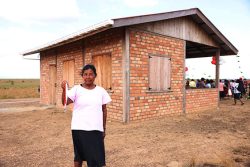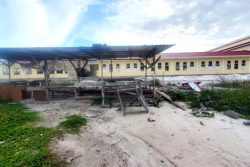By Robert B. Zoellick
Imagine if a city of almost four million people disappeared every year. A Los Angeles, Johannesburg, Yokohama. It would be hard to miss.
Yet it goes largely unnoticed that almost four million girls and women “go missing” each year in developing countries when compared to their female counterparts in developed countries. About two-fifths are never born; a sixth die in early childhood, and more than a third die in their reproductive years.
High mortality rates are just one of many barriers to equality between men and women, as argued in the World Bank’s new report. Equality is not just the right thing to do. It’s smart economics. How can an economy achieve full potential if it ignores, sidelines or fails to invest in half its population?
The world has taken significant steps over the past 25 years toward narrowing the gaps between men and women in education, health and labour markets.
Today, girls and boys participate equally in primary education in most developing countries; a third have more girls in secondary school than boys. At the university level, women now outnumber men in more than 60 countries.
Women are using their education to participate increasingly in the labour force, diversify their time beyond housework and childcare and shape their communities, economies and societies. Women now make up more than 40 per cent of the global labour force — including a large share of the world’s entrepreneurs and farmers.

This pace of change has been remarkable: For example, what took the United States 40 years to achieve in increasing girls’ school enrollment, Morocco did in a decade.
Other dimensions of equality, however, portray a more disturbing picture.
Girls who are poor, live in remote areas or belong to minority groups still cannot attend school as easily as boys. Women are more likely than men to work in low-paying occupations, to farm smaller plots and to manage smaller firms in less profitable sectors.
Whether workers, farmers or entrepreneurs, women earn less than men: 20 per cent less in Mexico and Egypt; 40 per cent less in Georgia, Germany or India; 66 per cent less in Ethiopia. Women —especially poor women— have less say over decisions and less control over household resources than men. Women’s voice and representation in society, business and politics is significantly lower than men’s — with little difference between poor and rich countries.
Leveling the playing field for women would offer huge potential.
Talk to Julian Omalla. This Ugandan business woman had trouble getting a loan in 2007. She was not alone. Ugandan women owned nearly 40 per cent of registered businesses, our research showed, but got less than 10 per cent of commercial credit. Since Omalla gained access to credit, thanks to Uganda’s DFCU Bank and the World Bank’s private sector arm the IFC, her food and beverage company has thrived. Today it employs hundreds of people.
Much more can be done to stop women from being economically marginalized.
Equalizing access to fertilizers, and other inputs for female and male farmers, for example, could increase agricultural yields in much of Africa by 11 per cent to 20 per cent. Removing obstacles to women that block certain sectors and occupations could raise output per worker by 3 per cent to 25 per cent — depending on the country. Legal reforms that would allow women to own land and businesses, or inherit property, can free them to become economic agents of change.
Putting resources in the hands of women has shown to be good not just for them, but also for their children. It increases a child’s chances of survival, health and nutrition and school performance.
Empowering women to use their talents and skills can boost countries’ competitiveness and support growth —a valuable, under-used resource in an uncertain global economy. During the 2008 financial crisis, women’s incomes helped keep many families afloat —hence the importance of ensuring that women’s productivity and incomes are not held down by market or institutional barriers, or overt discrimination.
This challenge is not just about developing countries. Around the world, one in 10 women will be sexually or physically abused by a partner, or someone she knows, over her lifetime.
The World Bank’s new report calls for action in four areas:
• addressing human capital issues, like the higher mortality of girls and women, through investment in clean water and maternal care and persistent disadvantages in education through targeted programmes;
• closing the earning and productivity gaps between women and men — by improving access to productive resources; water and electricity, and childcare;
• increasing participation by women in decisions made within households and societies; and
• limiting gender inequality across generations, by investing in the health and education of adolescent boys and girls, creating opportunities to improve their lives and offering family planning information.
We have seen that focused policy attention can make a difference. Sustainable solutions are best grounded in partnerships including families, the private sector, governments, development agencies and religious and civil society groups.
Even in the most traditional societies and poorest villages, I have seen that when women gain opportunities to earn more for their families, it quickly overcomes men’s suspicions — or even initial hostility.
But people often need a project that sparks a changed outlook. The poorest countries can accomplish much more with financial help. The World Bank will invest, in part, because the economic payoffs are large.
Gender equality is the right thing to do. And it is also smart economics. (This article first appeared on Politico.com on September 19, 2011.)
Robert B. Zoellick is the president of the World Bank Group. The new report, “World Development Report: Gender Equality and Development,” was released on September 19.







